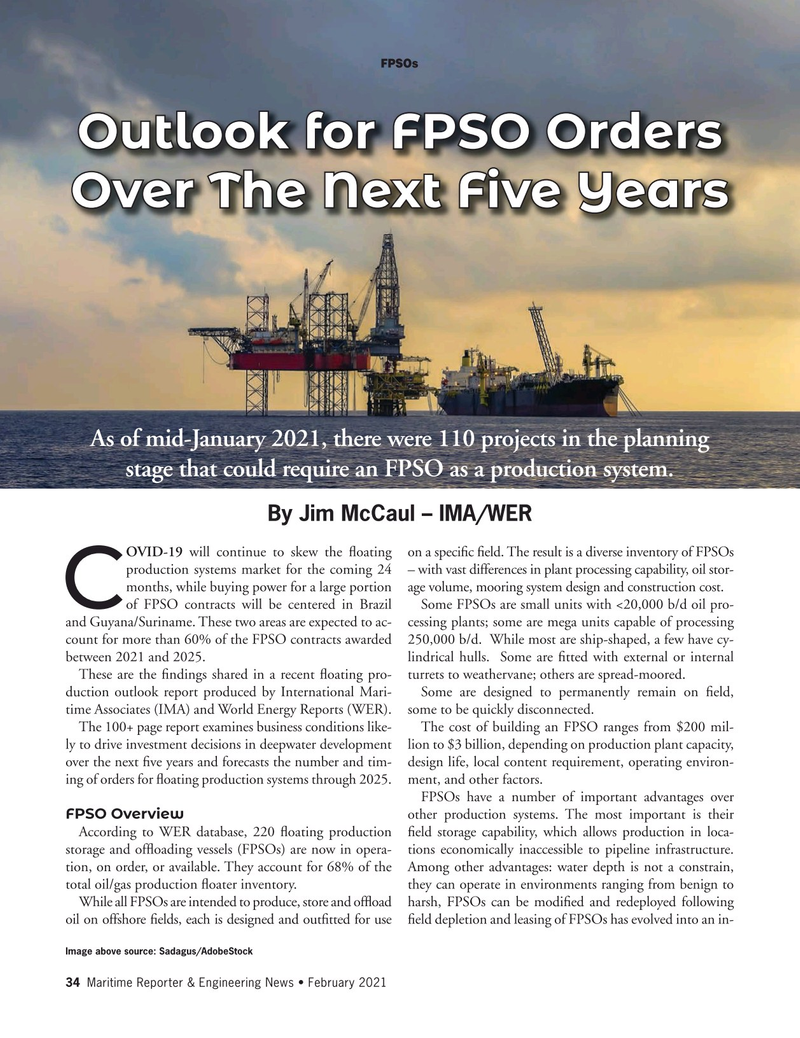
Page 34: of Maritime Reporter Magazine (February 2021)
Government Shipbuilding
Read this page in Pdf, Flash or Html5 edition of February 2021 Maritime Reporter Magazine
FPSOs
Outlook for FPSO Orders
Over The Next Five Years
As of mid-January 2021, there were 110 projects in the planning stage that could require an FPSO as a production system.
By Jim McCaul – IMA/WER
OVID-19 will continue to skew the ? oating on a speci? c ? eld. The result is a diverse inventory of FPSOs production systems market for the coming 24 – with vast differences in plant processing capability, oil stor- months, while buying power for a large portion age volume, mooring system design and construction cost.
Cof FPSO contracts will be centered in Brazil Some FPSOs are small units with <20,000 b/d oil pro- and Guyana/Suriname. These two areas are expected to ac- cessing plants; some are mega units capable of processing count for more than 60% of the FPSO contracts awarded 250,000 b/d. While most are ship-shaped, a few have cy- between 2021 and 2025. lindrical hulls. Some are ? tted with external or internal
These are the ? ndings shared in a recent ? oating pro- turrets to weathervane; others are spread-moored. duction outlook report produced by International Mari- Some are designed to permanently remain on ? eld, time Associates (IMA) and World Energy Reports (WER). some to be quickly disconnected.
The 100+ page report examines business conditions like- The cost of building an FPSO ranges from $200 mil- ly to drive investment decisions in deepwater development lion to $3 billion, depending on production plant capacity, over the next ? ve years and forecasts the number and tim- design life, local content requirement, operating environ- ing of orders for ? oating production systems through 2025. ment, and other factors.
FPSOs have a number of important advantages over
FPSO Overview other production systems. The most important is their
According to WER database, 220 ? oating production ? eld storage capability, which allows production in loca- storage and of? oading vessels (FPSOs) are now in opera- tions economically inaccessible to pipeline infrastructure. tion, on order, or available. They account for 68% of the Among other advantages: water depth is not a constrain, total oil/gas production ? oater inventory. they can operate in environments ranging from benign to
While all FPSOs are intended to produce, store and of? oad harsh, FPSOs can be modi? ed and redeployed following oil on offshore ? elds, each is designed and out? tted for use ? eld depletion and leasing of FPSOs has evolved into an in-
Image above source: Sadagus/AdobeStock 34 Maritime Reporter & Engineering News • February 2021
MR #2 (34-49).indd 34 2/4/2021 9:50:10 AM

 33
33

 35
35
